It’s almost that time of year again! Only a few days to go to start picking the early season’s Green Olives and just a few more weeks to begin harvesting this year’s bumper crop of Black Olives.
Being fortunate enough to live on the Sanctuary Lake Estate we can wander around the streets and common ground, picking ourselves a kilo or two of ripe olives for free and then spend a fun time curing our very own batch.
Greg Fryer and his Merry Gardeners have diligently over the years planted numerous Olive Trees on our common land. Just a few locations that are presently loaded with healthy nearly ripe green olives are the ten trees in Pelican Bay (next beach south of Partington Reserve) likewise adjacent to the 8th tee at the end of Times Square’s Lincoln Park Close and also off Times Square towards the 11th tee at the end Staten Way. In Jardin particularly in Montclair and Cremorne Street. Celebration Drive has dozens of healthy Manzanillo and Kalamata Olive trees. On either side of the bridges on the Panorama Way islands almost a two-dozen young Kalamata Olive trees (wait till they are Black and fully ripe). Healthy Kalamata and Manzanillo trees are also featuring in Morning Close and Viewbank Court, South Shore and Middle Park. And that is just a sample, there are many other Olive Trees on the resort’s common ground, with fruit almost ready for picking.
Before curing Olives, just a quickie on when to pick. All Olives will turn a dark purple black when ripe, but the full sized early green olive can also be cured into interesting tastes. Due to our strange weather patterns this year you have to pick by sight rather than timetable and on the larger trees not all the fruit ripens at the same time, there can be as much, as two weeks difference between ripened fruit on the same tree. Therefore, the three stages for picking are:
Green: Picked when they have obtained full size, but before the ripening cycle has begun. Usually shades of green to yellow.
Semi-ripe or Turning Colour Olives: Picked at the beginning of the ripening cycle, when the colour has begun to change from green to multi-colour shades of red to brown. Only the skin is coloured as the flesh of the fruit lacks pigmentation at this stage, unlike that of ripe olives.
Black Olives or Ripe Olives: Picked at full maturity when fully ripe. Found in assorted shades of purple to brown to black.
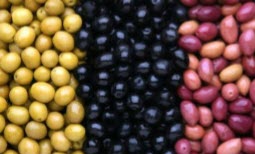
When you pick your Olives, you start the clock. You must utilize the olives, i.e. place them in water or brine, within three days of harvest. If they sit dry any longer, the olives will oxidize and “sour.”
World-wide there are hundreds of different varieties of Olives, often many are cultivar, cross breeding or grafted with compatible varieties to get the best plant to suit its situation. In Sanctuary Lakes we have at least four key Olive varieties, the most popular are the Manzanillo and Kalamata. And to make things even more complicated these two varieties are the most often cross grafted.
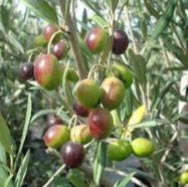
Manzanillo Olea Europa
Manzanillo: Originating from Spain, the Manzanillo olive has a medium to large fruit that can be pickled green or black. Fruit is tasty with a firm texture and has a smallish seed.
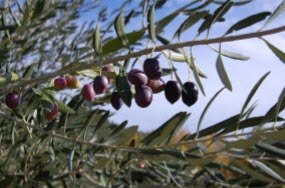
Kalamata
Kalamata: Named after the city of Kalamata in the southern Peloponnese, Greece. Famous for its production of olives and olive oil. Kalamata olives are almond shaped, with a deep rich, aubergine colour. They are freestone with good pulp to pit ratio, and have a distinctive flavour. Commonly used for table olives, and for olive oil as well. The leaves of the Kalamata olive tree are nearly twice the size of other varieties.
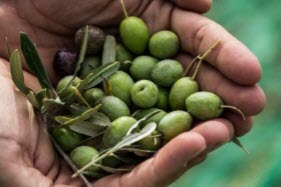
Arbequina
Arbequina: The popular olive from Catalonia are easily recognised as being larger and denser than other Olive trees, but the fruits are small and light brown in colour with a firm texture and mild, fruity taste. Arbequina is often cross grafted with the Beldi olive.
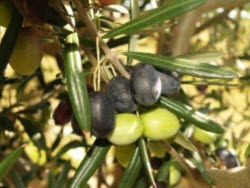
Coratina
Coratina: One of Italy's most important varieties. Coratina Olive trees grow faster and more erect than other varieties, and adapt well to many different growing environments and conditions. The fruit is large and oval shaped. Coratina Olives produce a very high-quality oil with high levels of polyphenols making it very stable. They are also suitable for use as table olives.
Remember the trees on Sanctuary Lake’s common land are mainly “wild” Olive trees, so always check them when picking for any foreign elements, bud mites and unnatural blemishes. I have always had perfect fruit in the last 6 years, but you must check carefully. And please they are our Olives, they belong to all of us, so when harvesting take good care of the Trees and just pick the fruit, not the branches.
Sanctuary Lakes Resident Services are very aware that there are a lot of residents who already cure, pickle and marinate Olives and there also many who wish to learn. Therefore, they are hosting an Olive fun event at mid-day on Sunday 7th April where we can have a mix of social fun, BBQ and an enjoyable master class on Olive curing, marinating and tasting. What will you need? Please bring along a chair or picnic rug, something to throw on the barbie (or a picnic), as well as a pen and notepad for all the tips and tricks.
If you have your own olives (raw, brined or marinated) please bring them along to the event and share your secrets with the group. We promise a great afternoon at the Southern Boulevards Beach.
See you there!